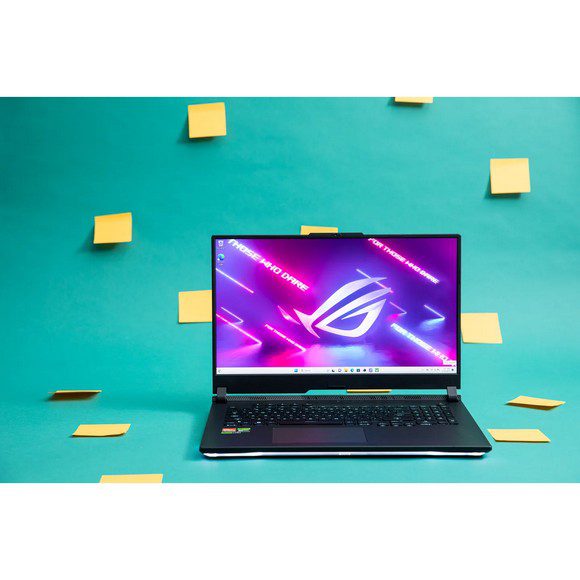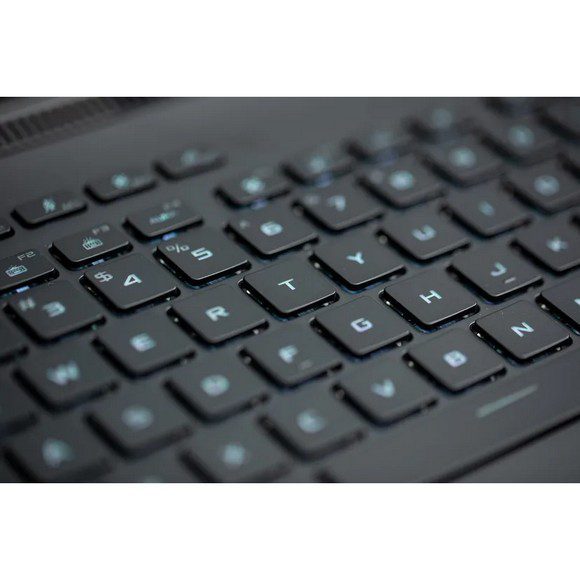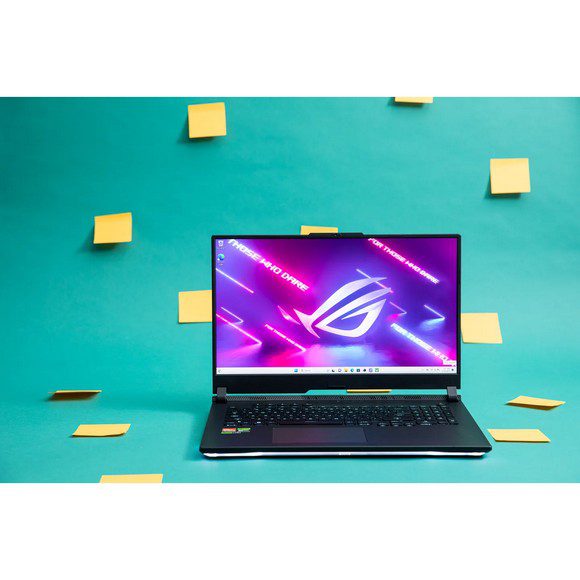The Ryzen 9 7945HX3D from AMD claims to be the world’s fastest mobile gaming CPU. It was accurate. Recently, AMD unveiled the new Ryzen 9 7945HX3D, a processor with 16 cores, 32 threads, a boost clock up to 5.4GHz, a TDP of over 55W, and a massive 144MB of total cache. It would be the “fastest mobile gaming processor in the world,” according to the manufacturer. AMD insisted that this chip will provide a superior gaming experience.
Recently, AMD unveiled the new Ryzen 9 7945HX3D, a processor with 16 cores, 32 threads, a boost clock up to 5.4GHz, a TDP of over 55W, and a massive 144MB of total cache. It would be the “fastest mobile gaming processor in the world,” according to the manufacturer. AMD insisted that this chip will provide a superior gaming experience.
Well, I now possess the processor. It’s within the enormous 17-inch ROG Strix Scar X3D laptop from Asus, which is covered in RGB. And people, I am seeing some utterly absurd figures from this. This Scar is having lunch on Intel. It greatly exceeds the capabilities of any gaming laptop I have ever examined.
Currently, this gadget costs $3,699.99 and also has 32GB of RAM, 1TB of storage, an Nvidia RTX 4090 GPU, and a 240Hz QHD screen. It’s a premium purchase, much like many of the best gaming laptops available today. This is likely to be one of those goods that many customers will buy more as a statement than as a practical purchase. And in this instance, the assertion is one that, as soon as AMD revealed this processor, we all kind of believed to be true: Intel is in trouble.

| THE GOOD | THE BAD |
| The best performance on the laptop market today | Mediocre webcam |
| Bright enough, 240Hz, QHD screen | Short battery life |
| Exceptional per-key RGB keyboard | Expensive |
| Great battery gaming experience |
This is, without a doubt, the best gaming performance you can get in today’s laptop market. These numbers are a good deal higher than I’ve ever seen. The X3D is beating MSI’s Titan GT77 HX, a more expensive RTX 4090 machine with Intel’s flagship Core i9-13980HX, by as much as 20 percent on the titles tested here. That’s a level of performance difference that you might expect to see from a GPU upgrade, not from merely the CPU alone.
It goes without saying that if you’re interested in gaming at QHD resolution, this is the laptop you want to be using. In most modern games, if you can afford it, you’re essentially paying to never have to worry about the settings, resolutions, or frame rates.
By the way, the Counter-Strike: Global Offensive number is not a mistake. Although it won’t matter on the 240Hz panel, the frame rate is so absurdly high compared to anything a gaming laptop has ever managed on any game that I felt compelled to mention it.
AMD’s 3D V-Cache is one of the main factors that contribute to these staggering results. The first mobile processor with this technology is the X3D chip, which has more cache than AMD’s existing desktop X3D range.
For those who are unaware, cache is fast memory that resides on the CPU. It is quite easy to get to. I like to think of it as the CPU’s “pocket,” saving the chip from having to search through the system RAM for something it needs if it is already in the cache. However, caching is also similar to a pocket in that it has a limited capacity. These kinds of devices measure it in megabytes, whereas RAM is measured in gigabytes.
AMD can add more cache to the CPU thanks to 3D V-Cache. This might significantly affect gaming laptops because games in particular demand extremely fast data processing from CPUs. The X3D should not be purchased to be used in an office because cache does not significantly affect productivity jobs like office work and other types of productivity chores. It is as much of a “gaming laptop” as gaming laptops get, just like the rest of the Strix family. It is exclusively for use in games. (After all, it weighs more than six pounds and is almost an inch thick. My back did not appreciate me carrying it in a backpack to and from the office.)
Asus ROG Strix Scar X3D benchmarks
| Title |
Frames per second
|
| Red Dead Redemption 2 | |
| Native | 123 |
| FHD | 149 |
| Shadow of the Tomb Raider | |
| Native (ray tracing on) | 133 |
| Native (ray tracing off) | 196 |
| FHD (ray tracing on) | 212 |
| FHD (ray tracing off) | 283 |
| Horizon Zero Dawn | |
| Native | 173 |
| FHD | 203 |
| CS:GO | |
| Native | 545 |
| FHD | 692 |
| Assassin’s Creed Valhalla | |
| Native | 142 |
| FHD | 181 |
The Strix Scar utilizes Asus’ ROG Intelligent Cooling system, which is a patchwork of Conductonaut Extreme thermal paste, 84-blade fans, four heatsinks, 0.1mm fins, anti-dust tunnels, and a vapor chamber that covers 43.3 percent of the motherboard. Everyone performed a fantastic job, and the enormous chassis undoubtedly helps. The CPU was quite consistently in the mid-80s (Celsius) during my gaming sessions, with just extremely sporadic jumps upward. The keyboard never got hot to the touch for me. Naturally, this is in a large laptop with plenty of space for all of this cooling equipment; once smaller 15-inch gaming laptops are available, we’ll have to see how simple it is to cool the new X3D CPU.
If you use the Turbo cooling profile, you will be able to hear the fans running (which, of course, I did — come on now). I would argue that’s not surprising given that they are cooling some of the most powerful laptop components currently available. Fortunately, if you’d prefer a more tranquil gaming experience, the Silent profile is available for you.
Other matters I like
this enormous display. Although I detest carrying around 17-inch laptops, I adore staring at 17-inch screens. On a screen this big, the resolution, which is 2560 x 1440 and, yes, has the hated 16:9 aspect ratio, doesn’t really matter.
The panel has a 100% coverage of the sRGB gamut, an 87.5% coverage of Adobe RGB, and a 99.5% coverage of P3. With a maximum brightness of 368 nits during testing, it is brighter than normal for a gaming laptop.
Overall, the games look nice, and Asus’ Armoury Crate software offers a bewildering variety of color profiles for you to select from.
Every port you require. Port space is abundant on large computers. On the left are two USB-A ports. Two USB-C, an HDMI, an ethernet, and a power port are all crammed into the back. I resent having to reach around and plug things into the back, but I concede that it is a functional location for them. Additionally, the X3D supports Wi-Fi 6E and 2.5G LAN. One of the two USB-C ports provides 100W power delivery, and both support G-Sync.
I certainly believe that having ports on the right side would be beneficial. I can see how some individuals might wish to place a mouse in there or use a stationary monitor, for example.
Asus ROG Strix Scar X3D specs (as reviewed)
- 17-inch IPS QHD, 240Hz display, 3ms, 300 nits, 100 percent DCI-P3
- AMD Ryzen 9 7945HX3D, 55W default TDP, 5.4GHz boost, clock, 16 cores / 32 threads
- Nvidia RTX 4090, 150W+25W, 16GB VRAM
- UP to 64GB Dual Channel DDR5 4800MHz (2 x SODIMM slot)
- 2 x PCIE 4.0 SSD M.2 Slots, up to 1 x 2TB 4×4 SSD included (up to 7000MB/S)
- 720p webcam
- Wi-Fi 6E + BT 5.2
- 90Whr battery
- 330W adapter
I could type all day on this keyboard. This is genuinely one of the greatest keyboards I’ve tested this year, even though I know I say that about ROG gaming computers all the time. The smoothness of the keys is pleasant, and they appear to be the ideal size for my fingertips. They bounce in a way that is extremely pleasurable. They don’t say much. The right side has a numpad, and I’ve been making an effort to use it because the keys are so nice and easy to press.
Naturally, per-key RGB lighting is a need for any Strix. The X3D’s is elegant and evenly distributed. The keyboard ensures a vibrant environment in conjunction with a not-at-all-subtle light strip that runs along the bottom.
Things I don’t like quite as much
The webcam is bad. It’s a grainy 720p affair. I mean, the last Strix I reviewed didn’t have a webcam at all, so I’m glad to see that we’re making progress. But still — $3699.99, 720p, in 2023.
Well, battery life. It’s not a Zephyrus. This device lasted for three and a half hours of ordinary (non-gaming) office use before it failed. (Battery Saver was enabled, medium brightness, and Silent mode were used.) Here, the MSI Titan GT77 laptop has a tiny advantage over the X3D because it has a larger battery. I got around one hour and a half more usage time from the MSI. That said, I believe you need to, like, go for a swim or something to clear your head if you’re buying one of these massive six-pound computers and are basing your decision on battery life.
The good news is that Red Dead Redemption 2 played flawlessly for 54 minutes on the X3D’s battery. I was actually astonished when the game abruptly ended because it was so playable throughout, with barely a stutter. The X3D was charged by the bundled 330W charger very quickly as well, reaching 60 percent in only 37 minutes.
Agree to Continue: Asus ROG Strix Scar X3D
The mandatory policies, for which an agreement is required, are:
- A request for your region
- Microsoft Software License Terms
Optional things to agree to:
- Device privacy settings: Find My Device, inking and typing, advertising ID, location, diagnostic data, tailored experiences
- Microsoft 365 free trial
- Join Xbox Game Pass
- Provide your name, email region, and phone number to allow McAfee to send you service-related email and text notices
That’s two mandatory agreements and nine optional ones
AMD completed the task. It made the Strix Scar X3D a blisteringly powerful laptop that easily outperforms the competition and brought 3D V-Cache to the mobile market.
The decision should be rather straightforward for those with $3,700 to spare: purchase the X3D if frame rates are your top priority and you want the best of the best. You should start looking elsewhere as soon as you start caring about other factors, such as webcam quality, portability, or battery life.
Personally, I’m more curious in the X3D’s potential in the gaming laptop market. I was testing this and it brought back memories of testing the ROG Zephyrus G14 in 2020. I can still picture me repeatedly verifying those numbers. AMD had completely altered our perception of what a gaming laptop was capable of. And it might have just repeated that, in my opinion.

